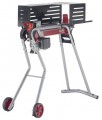Splitting force
The greatest force that the wood splitter is able to apply to the workpiece in the process of splitting.
This parameter is relevant for hydraulic and rack units (see "Type"). Even in the simplest such devices, the splitting force reaches several tons. In general, high force allows you to cope with hard and thick workpieces, however, it requires high power and strength, which significantly affects the price and weight of the entire unit. Therefore, it is worth choosing a model according to this characteristic, taking into account the specifics of the work.
So, for use in the private sector, a wood splitter with a splitting force of up
to 5 tons is considered quite sufficient, for boiler rooms and other relatively large consumers —
5-8 tons (up to 10 tons), and
more powerful devices are intended mainly for industrial use.
Max. log length
The longest log that a log splitter can handle. In fact, this is the largest distance that the stop and working nozzle can be spread; if the workpiece is longer than this distance, it will have to be sawn.
Note that this indicator significantly affects the dimensions (especially in a horizontal working position), and the force required to split a long log is quite high. Therefore, for small volumes of work (for example, when harvesting firewood for a private house), a wood splitter with a relatively small maximum length is often the best choice —
up to 60 cm ; longer workpieces can be sawn. But models of
more than 60 cm are intended mainly for work on a large scale.
Cylinder stroke
The distance between the two extreme points of piston movement in the hydraulic log splitter (see "Type"). The greater this distance, the greater, usually, the maximum log length can be (see above). In addition, knowing the stroke of the piston, you can approximately estimate the smallest length of the log that the wood splitter can handle. For example, if the stroke is 60 cm, and the maximum log length is 80 cm, then the minimum distance between the nozzle and the stop will be 80 — 60 = 20 cm. For a guaranteed split in such a wood splitter, the log must be no shorter than 25 — 30 cm.
Working stroke (split/return)
The time during which the moving element of the wood splitter (stop or working nozzle) passes from the starting point to the end position and back. In fact, this is the shortest time spent by the unit to split one log. Note that when working with solid wood, the stroke may be slightly larger than stated, although often this difference is practically not noticeable.
Splitting speed
The time it takes for the cleaver/knife to move from the top end position to the bottom end position. The splitting speed is measured in centimeters per second (cm/s). The average wood splitter has a speed of 4 cm / s. This indicator is influenced by both the drive power and the piston stroke height. In turn, the splitting speed itself affects the performance of the wood splitter — the higher it is, the faster the device will cope with the work.
Return speed
The time it takes for the cleaver/knife to move from the lowest position to the highest position. It is measured in centimeters per second cm/s. Together with the splitting speed parameter, the return speed determines the travel time. An ordinary average wood splitter returns the cleaver to the working (upper) position in 7-8 seconds.
Protective box
Models that are equipped with a
protective box that prevents the log from falling apart and the logs falling down after it is split. It is designed to stop chips and logs that can scatter in all directions under the pressure of the knife. Often, a protective box is created from perforated sheet metal. Thanks to the perforation, the wood splitter operator can visually control what is happening in the working area. Most often, the protective box is installed on wood splitters with a horizontal log arrangement. In such models, when chopping firewood, the wood can literally “shoot” forward, which can be dangerous. And in vertical wood splitters, wood chips always just fly down, which in itself is absolutely safe.

